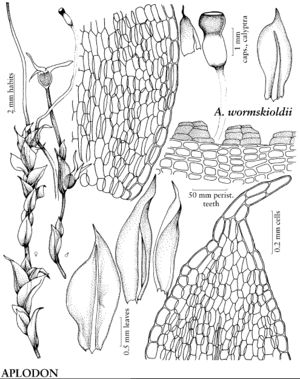Aplodon
Chlor. Melvill., 41. 1823.
| Taxon | Illustrator ⠉ | |
|---|---|---|
 | Aplodon wormskioldii | Patricia M. Eckel |
Plants in slender lax tufts, light green distally. Stems 6 cm; rhizoids dense proximally. Stem-leaves broadly ovate or obovate; margins entire; apex obtuse to acute and abruptly short-acuminate; costa ending before apex; proximal laminal cells rounded-rectangular; distal cells oblong-hexagonal. Sexual condition autoicous. Seta 1–2 cm, twisted, flexuose. Capsule not cleistocarpous, reddish, black with age, shrunken and widest at mouth when dry, ovate when moist; hypophysis same color as urn, rounded, elongate, not or slightly wider than urn; annulus weakly differentiated; operculum hemispheric, sometimes apiculate; peristome single; exostome teeth 8–12, at first in pairs, then separate, erect or reflexed, rudimentary. Calyptra mitrate or cucullate, conic, not constricted beyond base. Spores 10–15 µm, smooth.
Distribution
n North America, n Eurasia, subarctic to Arctic regions
Discussion
Species 1.
Although plants of Aplodon have an inflated hypophysis, based upon the molecular data, placement of the genus is not well resolved within Splachnaceae, and its relationship to or within this family requires further study (B. Goffinet et. al. 2004).
Selected References
None.
Lower Taxa
"widest" is not a number.